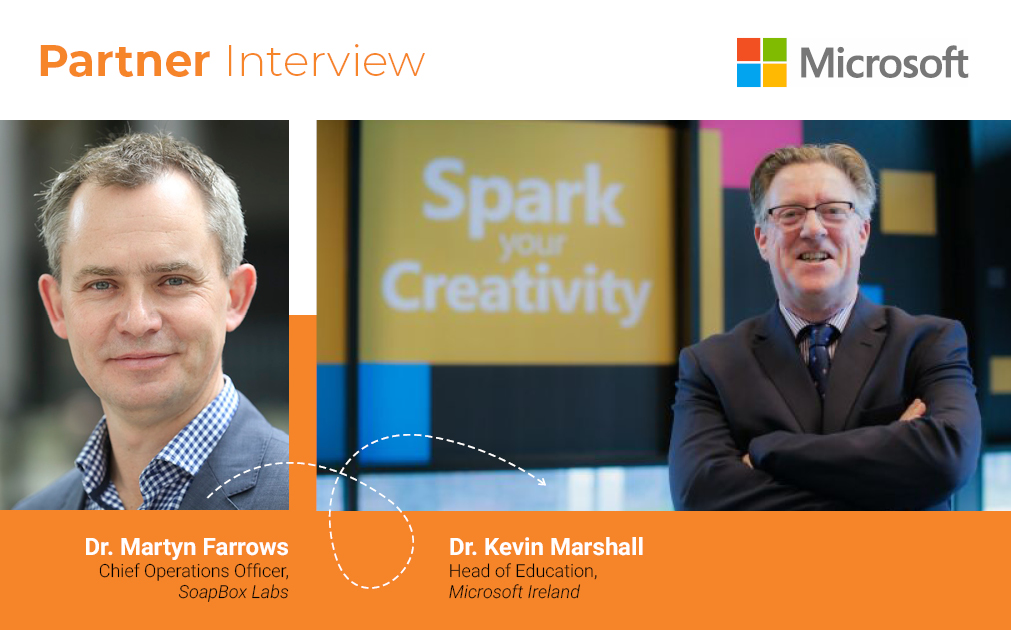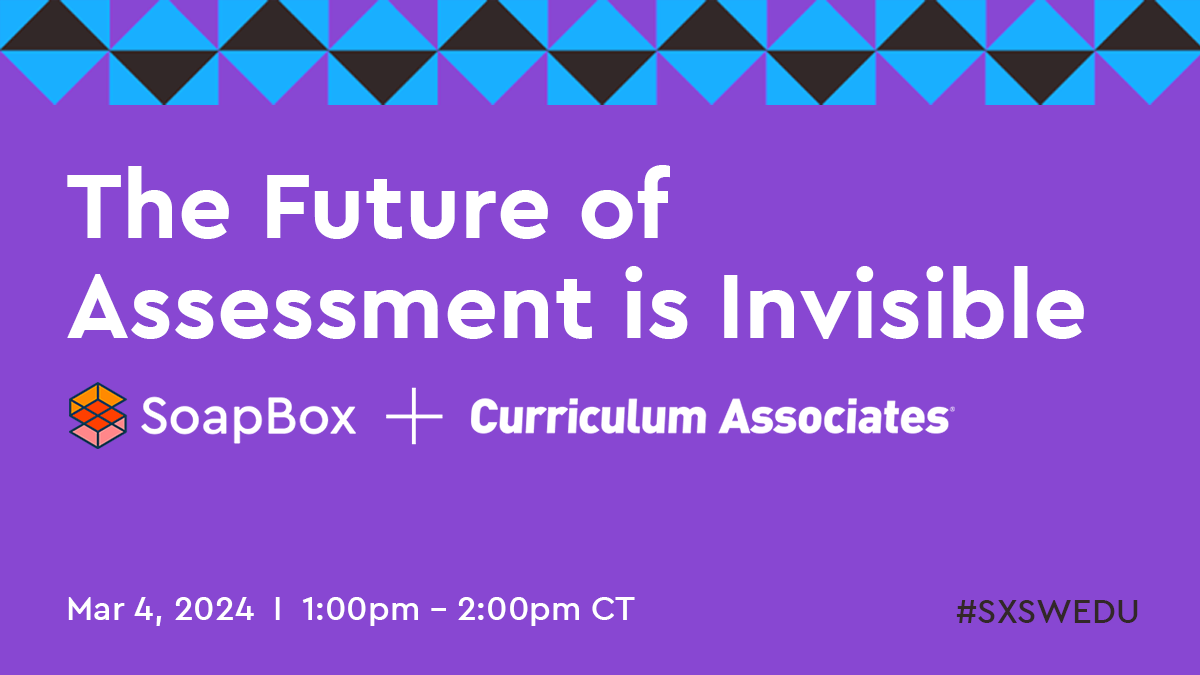Our Partnership with Microsoft
September 30, 2020

In March 2019, SoapBox Labs and Microsoft became partners in tackling the global literacy crisis. Earlier this month, Niamh Bushnell sat down with COO Dr. Martyn Farrows and Dr. Kevin Marshall from Microsoft Education to talk about our work to date and the important role voice technology plays in supporting literacy for kids.
Q: Why is the SoapBox Labs Microsoft partnership so important?
Kevin:
To start with, Microsoft has had a long history in education and education programs since its foundation over 30 years ago. In the early 2000s, we launched a program called ‘Partners in Learning’ which had a big focus on teachers and disadvantaged communities and students. While lots has changed since then in terms of society and technology, the area of student assessment has not changed much and still today we need to look for new ways to make both summative and formative assessments more beneficial to students, and more relevant to their learning needs. The emergence of new models of education, and of new technologies like voice show us the role artificial intelligence can potentially play in tackling the literacy crisis and in the last six months voice technology has become even more important as a way to assess kids, in a way that provides immediate data and feedback that can be instantaneous.
Martyn:
When we put this partnership together with Kevin and Cathriona Hallahan from Microsoft Ireland, and with support in the US from Peggy Johnson, the emphasis was on our vision and belief that speech recognition could be used to support kids on their literacy and language learning journey. We saw voice technology becoming more mainstream as a utility, like in voice assistants, but we believed there was an application for it that was much deeper than that. So we built this global literacy challenge-type project with Microsoft – an AI for Good project – and we focused on kids at the very early stages of their literacy journey; phonics and letter sounds, blending, decoding, and demonstrated that the technology was powerful enough to make an impact. We documented that in a white paper you can download from our website called Fostering Literacy.
We then started to apply the technology to support edtech company products and needed to deliver it on a platform that was robust enough, scalable enough and global enough to support that overall vision. And that’s where the Azure relationship came in.
The recent announcement with Amplify in the US is a really powerful example of how far we’ve come in 18 months working together with Microsoft. The Amplify product Text Reading Online has now gone out to hundreds of thousands of kids across the US, and in this COVID era when kids may not be at school but still need teachers to give them effective assessments around their reading proficiency, it’s incredibly powerful.
Q: You have a background in the education sector in the US Kevin, tell us more.
Kevin:
I worked in the Boston Public Schools system from about 1990 to 2001 in the area of research assessment and evaluation and we were responsible for all the psychometric testing that went on at the time. We were also involved in thinking about new forms of assessment because the US had, and still has, a heavy reliance on standardized testing. We were talking back then about some of the same stuff we’re talking about still today – moving away from paper and pencil to technology, and the same challenges exist in terms of the mindset today also.
Q: Do you see voice technology as an exciting opportunity for education now?
Kevin:
The product that Amplify has built is a really good product and very solid in terms of how it builds on the notion of the developmental continuum for learning, underpinned by assessment technology. Traditionally, we just think of one score on one test as opposed to scores on a continuum that allow educators to track progress over time rather than at any one given time. The products Amplify have developed belong to that newer continuum way of thinking about the world now. Add voice to that and you add a whole new approach to supporting students in their learning at whatever age. There’s a massive opportunity for this to become a solution for school districts and schools to integrate into their learning programs. It’s fundamentally about the power of children to learn, the power of machine learning, and the power of thinking differently about how we tackle some really serious problems, so yes, it’s really, really exciting.
Q: Will voice-enabled assessments become the new normal for schools and students?
Kevin:
Yes, and without COVID I think we still would have arrived there over time, but slowly. Education is traditionally very conservative and very slow to change even though it should be the one thing to change all the time. There’s so much new technology and ways of thinking out there that can be integrated into programs, but the system side of it doesn’t see it like that, particularly when it comes to assessments and how in the traditional way they don’t support everyone and can create inequality. The last six months have accelerated the need to do things differently because people can’t physically come together. So voice technology is a powerful piece of technology that’s actually filling a huge void. Some things in life are just a matter of the right place and right time. It’s been a horrible year so far for the world, but there are certain unintended consequences that are potentially of huge benefit and I think this is one.
Martyn:
Traditionally, we measure and produce reading records by doing in-person assessments, sitting alongside a child and marking on a piece of paper how they’re progressing based on a rubric. Because that’s a time consuming thing to do, you tend to only do it maybe once or twice a year. With voice technology, you can remove a lot of the resource issue because, as Kevin said, you can monitor kids on a weekly basis, while they’re reading out loud, and score that, in an informal, formative and invisible, in the background, kind of way. I think voice-enabled assessments are just a really great example of technology being a support mechanism for the teacher in how they support kids’ learning.
Q: Let’s talk about how voice technology supports equity in a classroom.
Kevin:
Equity is one of the differentiators that voice technology brings you. But I think the bigger one for me really is that it allows you to do assessments on an ongoing basis. You don’t have to wait six months, you can build this into ongoing formative assessments or just by tracking a child’s performance and giving feedback instantaneously that the child can learn and the teacher can see. That’s hugely powerful. So, in that way, that’s what equity is, that idea that if you get that right, no one falls behind. If you have the data and if the data was captured accurately and ethically, it gives you insights into the complexity of a child’s reading development. That’s the value of big data. You don’t have to wait six months or a year or even two months. You can build these intervention models quickly and there’s huge value in that.
Q: Microsoft’s recent research with McKinsey highlighted the importance of feedback to students, tell us more.
Kevin:
Yes, there are a couple of big things in the McKinsey study. One is the notion of the greater connection for students with teachers. The second thing is the notion of feedback, or better, quicker feedback, and another was personalized learning and the platforms to support that.
Voice enabling assessments allows teachers to give speedy feedback particularly in the guise of formative assessments, which opens the door to potentially much richer conversations between students and teachers. I think that’s hugely beneficial. And then, if you link that in with the notion of personalized learning, there’s huge possibilities to build in these automated smart assessment models, enabled by voice, across a whole range of subject areas and integrated with other kinds of technologies. So, in essence, what you build out is this notion of an AI assessment platform, in its broadest sense, where you have multiple pieces of technology, all integrated, and voice is right in the middle of that. That’s something that’s not done yet. I haven’t seen it anywhere, but it’s hugely beneficial and has huge potential.
Q: So, what’s next for our partnership?
Kevin:
I think we just need to grow this, scale this, learn and keep looking at other opportunities where we can work together and have impact in Ireland, the US and globally.
Martyn:
There’s one really practical thing, which is that now SoapBox is on Azure and part of that broader ecosystem and the Developer Network. We’re starting to make it very easy for other customers, who are on the Azure cloud infrastructure, to be able to integrate our technology. So access to our platform is becoming much more straightforward and it’s a great shop window for us in terms of being part of that Azure ecosystem. We’re working in South East Asia, where we’re supporting edtech companies offering language learning, and in mainland China, where we’ve got customers supporting kids as young as 2 years old who are starting to use technology to learn English. Thanks to our partnership with Microsoft, all of these bigger opportunities are now there for us.
Read more: Announcement of our partnership with Microsoft – March 2019




